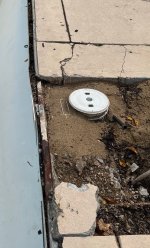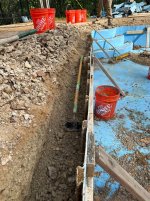I am doing a "light refresh"  on one wall of my hybrid pool. There is an angle iron that runs the length of the wall but has rusted away to nothing. I am sure they had a purpose at one time but are doing nothing except waiting to give someone lockjaw.
on one wall of my hybrid pool. There is an angle iron that runs the length of the wall but has rusted away to nothing. I am sure they had a purpose at one time but are doing nothing except waiting to give someone lockjaw.


I found the following picture from an old thread which shows the setup of the fiberglass walls prior to backfilling.

According to the thread which contained the attached pic, the poster had access to the original installation instructions which I would love to have a copy of but I suspect they are more rare than hens teeth at this point.
My question is, what is the function/purpose of the angle iron and do I need to replace it during my rebuild?
Based on the picture, I would guess the purpose is to keep the top of the panes straight during the backfill process.
My pool has concrete behind the wall which seems to have shifted and pushed the top of my pool wall inwards.
I have read in the same thread that crushed stone is used for the backfill. Any advice on concrete vs stone?


I found the following picture from an old thread which shows the setup of the fiberglass walls prior to backfilling.

According to the thread which contained the attached pic, the poster had access to the original installation instructions which I would love to have a copy of but I suspect they are more rare than hens teeth at this point.
My question is, what is the function/purpose of the angle iron and do I need to replace it during my rebuild?
Based on the picture, I would guess the purpose is to keep the top of the panes straight during the backfill process.
My pool has concrete behind the wall which seems to have shifted and pushed the top of my pool wall inwards.
I have read in the same thread that crushed stone is used for the backfill. Any advice on concrete vs stone?
Last edited:







